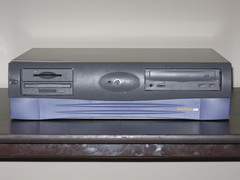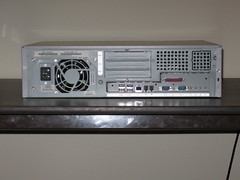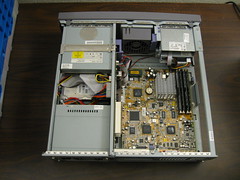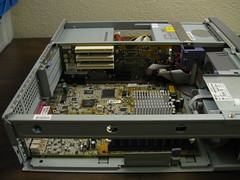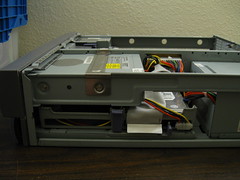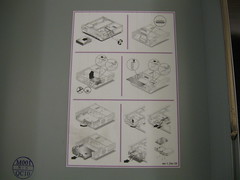Sun Blade 100
Specifications
Blade 100 Standard Features
- Sun UltraSPARC IIe 500MHz processor
- Sun PGX64 8MB integrated graphics card (ATI Rage XL)
- Sun serial smart card reader
- 3.5" floppy drive
- 5.25" external bay
- 2 internal 3.5" hard drive bays
- 3 PCI slots
- 2 ATA66 channels
- 4 PC133 DIMM slots (max 512MiB per slot, 2048MiB total, Unbuffered ECC only)
- 4 USB 1.1 ports
- 100MB/s Ethernet
- 2 Firewire ports
- DB-9 serial port, DB-25 parallel port
- ALi M5451 audio, 4 ports plus onboard speaker
- Sun Type 6 keyboard/mouse
- Solaris 8 operating system
Currently Configured
- 2048MiB RAM (four 512MiB sticks)
- Lite-On LTN486S 48x ATAPI CD-ROM drive (Sun branding)
- Western Digital WD800 80GB ATA hard drive
- Debian 4.0 "etch" operating system
History
The Sun Blade series was introduced in 2000 as a replacement to the Ultra series. The Sun Blade 100 was sold in 2001 and 2002 as a low-end Blade workstation. The UltraSPARC IIe 500MHz processor was respectable in its time, but only had 256KiB L2 cache, as opposed to 2048KiB in the mid-range Blade 150's UltraSparc IIi processors, or 8192KiB in the high-end Blade 2000's UltraSPARC III processors.
Still, the Blade series was a major departure for Sun, using more "commodity" (PC) hardware systems. PCI replaced SBUS/UPA (while PCI was introduced in the Ultra 10, it wasn't standardized for a Sun line until the Blade series). VGA replaced 13W3. USB replaced Sun's proprietary Mini-DIN keyboard/mouse port. Firewire was standard. And the Blade 100 included all of these.
In August 2008, I bought a Sun Blade 100 from the Unix Surplus junk booth at DEFCON's vendor area for $30, as I tend to collect old and eccentric (read: non-x86) computers. It wasn't until I brought it home that I realized how much work it would take to get it working again. The computer had been dropped on the front left corner at some point, which resulted in a bent frame, a broken power switch, a dead hard drive, and surprisingly little visible exterior damage (minor scratching), considering the significant interior damage. Over the next 3 months, I proceeded to repair and upgrade the system.
Restoration
The power button's switch would usually stick closed. As a result, if you pressed the power button, the system would turn on, then turn off 4 seconds later. I temporarily worked around it by cutting and stripping the power button's wires, and manually shorting the wires when I wanted to power it on. I disassembled the switch assembly, found the part number (C&K 8125SHZBE), and was able to order a new replacement part on eBay for $4.
The system came with a single 256MiB stick, but it was installed in the wrong slot. Apparently the system must be populated starting with Slot 0. Of course not knowing this, combined with the above power button problems, meant that it was hours before I was even able to get to the OBP.
The 256MiB stick was good, but I wanted to upgrade the memory, if possible. The Blade 100 only accepts Unbuffered ECC memory, in PC133 or PC100. This combination was relatively rare (usually ECC is combined with Registered memory), and as a result, I was having trouble finding cheap RAM, with prices averaging $50 per 256MiB stick. However, I eventually came across an eBay store selling 512MiB PC133 ECC Unbuffered pairs for $15. I quickly bought 2 pairs, and maxed out the memory with 2048MiB.
The warped frame was fixed with some TLC, and by TLC, I mean I hit it with a hammer until it looked OK. The faceplate is a little cracked, but otherwise the chassis looks fine. The faceplate is missing the Sun logo, but I have not been able to find a replacement faceplate.
The 15GB Seagate hard drive that came with the Blase 100 was dead. I initially replaced it with a 13.6GB Western Digital drive. Debian installed on this with no problem, but I wanted a larger hard drive. I eventually found an 80GB WD, but when I tried to install Debian, Linux was having problems recognizing the capacity as over 32GB. This was frustrating, as I found other people mention installing 80GB drives into their Blade 100s without problem. I upgraded OBP 4.5.9 (2002/02/07) to 4.17.1 (2005/04/11), which fixed the problem.
One glaring omission by Sun is that you cannot enter OBP from the OS using a regular USB keyboard. You can enter OBP from the serial console using Ctrl-Break, and Sun keyboards can do Stop-A, but there is no way to enter OBP from a non-Sun USB keyboard. I found a Sun Type 6 USB keyboard on eBay for $6. (Incidentally, the Sun mouse in the keyboard is there just for show. It's actually a Sun Mini-DIN mouse from an Ultra 1 I had lying around. A real Sun USB mouse would have cost at least $35 used.) If you do want to enter OBP immediately after boot, press the power button twice quickly, immediately after you hear the power-on beep.
The smart card reader is untested, as I do not have a compatible smart card to test, and I'm not sure of Linux's support for the specific hardware. The floppy drive is also untested because, well, it's a floppy drive.
Linux on the Blade 100
The Blade 100 is quite well supported by Linux, primarily due to its similarity to a standard (old) x86 PC. On a Debian 4.0 etch standard installation, nearly everything works out of the box (USB, sound, Ethernet, ATA, etc). The only exception is the graphics sytem, but the fixes are simple.
Console Framebuffer
Before you do anything, set this in OBP:ok set output-device screen:r1024x768x60 ok reset-all
Also, any time you boot Linux, you will need to pass the following command line argument:
(SILO) boot: Linux video=atyfb:1024x768@60
Replace "Linux" with your boot profile; "Linux" is the default boot profile for Debian, while "install" is the default boot profile for the Debian-installer CD. You can make this easier by adding it to silo.conf:
image=/vmlinuz
label=Linux
initrd=/initrd.img
append="video=atyfb:1024x768@60"
This is for the benefit of the Linux console framebuffer; without this, you are likely to get an "out of range" error on your monitor.
Xorg
The above fix is for the benefit of the Linux console framebuffer, and is unrelated to the Xorg configuration, which supports up to 1280x1024. Xorg itself is mostly automatically configured by Debian, though you do have to add one line to make it work. Here's the relevant part of my configuration:
Section "Device"
Identifier "ATI Technologies 3D Rage Pro or similar (ATY,RageXL)"
Driver "ati"
BusID "PCI:0:19:0"
Option "UseFBDev" "true"
Option "reference_clock" "29.5 MHz"
EndSection
Everything in that section was added by Debian, with the exception of the "reference_clock" line, which you must add yourself for Xorg to work.
Hard drive
As mentioned above, the Blade 100 ships with one or two 15GB ATA drives. The version of the OBP firmware that shipped with the Blade 100, 4.5.9 in my case, would not support hard drives over 32GB. To use larger drives, upgrade to the latest version of OBP released for the Blade 100, 4.17.1, which has worked fine for me.
Sound
Again, sound works perfectly out of the box, but it's worth noting that the built-in speaker is enabled by default, and is available via its own channel in ALSA. "Master" controls the Line Out port on the back of the chassis, while "Master Mono" controls the built-in speaker. Plugging speakers into the Line Out port on the back will NOT automatically mute the built-in speaker, so be sure to mute the "Master Mono" channel before playing the My Little Pony soundtrack at work.
Gallery
Resources
- Sun Blade 100 specifications
- Sun Blade 100 FAQ
- Gentoo SPARC FAQ (mostly Linux generic, not Gentoo-specific)

